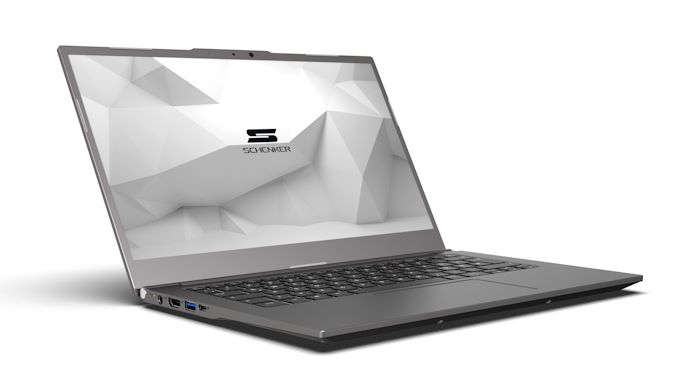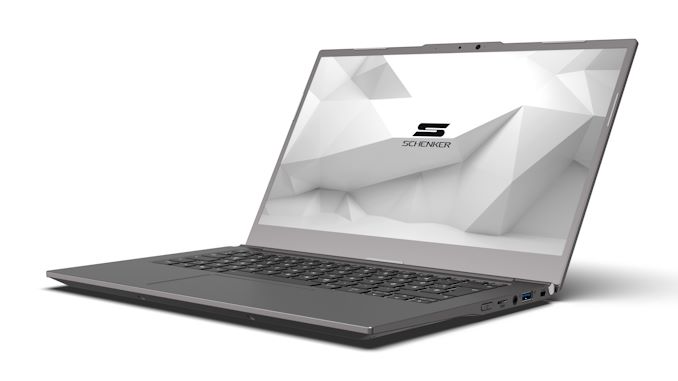Schenker VIA 14: 14-inch Tiger Lake Magnesium Notebook, with 28W Version Inbound
by Dr. Ian Cutress on September 2, 2020 1:00 PM EST
With Intel lifting the lid on its new Tiger Lake mobile processors today, a number of vendors are announcing their upcoming notebooks. Schenker Technologies, a German brand known in Europe for its Xtreme Mobile Gaming (XMG) line of products and custom Clevo implementations, is one of the first to describe an upcoming 11th Gen Intel Tiger Lake portable notebook as part of its VIA line. With a lightweight magnesium chassis, the VIA 14 uses up to a Core i7, a 73 Wh battery, and a one watt display to give 14+ hours of battery life.
The key thing to note about Tiger Lake is the increase in both CPU and GPU performance compared to the previous generation Intel notebook processors. We still have four cores, but the Tiger Lake cores can now boost a lot higher due to Intel’s improved 10nm SuperFin process (which you can read about here). Tiger Lake is Intel’s first product with its new Xe-LP graphics design as well, promising 2x the graphics performance of the last generation. The goal with these processors is to enable a nice and comfortable experience in a range of designs from ultra-premium to the run-of-the-mill.
The Schenker VIA 14 sits in that ultra-premium market. Using a lightweight magnesium chassis, the kind that we only ever see on the expensive end of the market, the VIA 14 is claiming only a 1.1 kg (2.4 lbs) weight despite also putting a 73 Wh battery inside. Personally I find this a bit mind blowing, if I’m honest. A 73 watt-hour battery in a 1.1 kg notebook is insane, and they are also claiming a 90% charge in 90 minutes. Not only that, but there’s also one of Intel’s approved low-power one-watt displays, enabling 14+ hours of active battery life according to the press release when at 150 nits.
Tiger Lake also enables PCIe 4.0 storage, native Thunderbolt 4, and Schenker will also support an optional LTE modem for business customers. Despite being lightweight, the big battery means the notebook is 16.5 mm, but with a 14-inch display is still very portable. The ports with the VIA 14 include a HDMI 2.0b connection, a USB 4.0/Thunderbolt 4 Type-C with DisplayPort 1.4b support, two USB-A 3.2 ports, a microSD card reader and a combination headphone jack. Native connectivity is through Wi-Fi 6, and as mentioned, an LTE add-on is supported.
For storage, the VIA 14 has support for two M.2 SSDs, one at PCIe 4.0 and the other at PCIe 3.0. Memory is DDR4-3200, with 8 GB coming pre-soldered and an 8 GB SO-DIMM module coming as standard, however up to 40 GB total memory can be supported. The 14-inch display has a maximum brightness of 300 nits and provides 98% coverage – Schenker says the special ‘one-watt’ display applies when running at 150 nits. The display also opens to a 180-degree hinge.
Prices for the VIA 14 will start at €1,246.75 (that includes 16% VAT) at the end of October. The base model features the Core i7-1165G7, 8 GB DDR4, and a 250 GB Samsung 860 Evo SSD, and models with the Core i5-1135G7 will follow later.
Schenker also included a preview of what is to come, simply stating that a version with a 28 W Tiger Lake processor paired with an NVIDIA graphics card will be ‘coming soon’.
Related Reading
- Intel’s 11th Gen Core Tiger Lake SoC Detailed: SuperFin, Willow Cove and Xe-LP
- Intel Schedules Tiger Lake Architecture Presentation For August 13th, Launch on September 2nd
- Hot Chips 2020 Live Blog: Intel's Tiger Lake Mobile CPU (12:30pm PT)
- Intel Thunderbolt 4 Update: Controllers and Tiger Lake in 2020
- I Ran Off with Intel’s Tiger Lake Wafer. Who Wants a Die Shot?











33 Comments
View All Comments
damianrobertjones - Wednesday, September 2, 2020 - link
Yes, 8Gb is PERFECTLY fine for general use.Now... how about increasing the standard refresh from 60, to 70?
Roy2002 - Wednesday, September 2, 2020 - link
60hz refresh rate is Ok for this non-game oriented laptop.III-V - Wednesday, September 2, 2020 - link
You can't just arbitrarily change the refresh rate without consequences. There are reasons why refresh rates are multiples of either 30 or 24 Hz.ajp_anton - Wednesday, September 2, 2020 - link
And what are those reasons? And why don't they apply on 85Hz, 90Hz, 100Hz or 165Hz screens?TheRealPD - Wednesday, September 2, 2020 - link
Standard explanation is about reducing video playback judder.So, by way of explanation, an average NTSC TV from a few years ago would have a standard refresh rate of 120Hz - which is exactly divisible by both 24fps for film & 30fps/60fps for broadcast content...
...whilst the equivalent PAL (& most of mainland Europe) TV would playback at 100fps - which was a compromise since 600fps would me needed to hit a multiple of both 24fps AND 25/50fps...
...HOWEVER, unlike the at least the US & Canada, from the middle of the VHS days onward, over here our devices are typically both PAL & NTSC compatible, so our equivalent TVs would be able to playback at both 100 & 120Hz.
(obviously there are now much higher refresh rate NTSC & PAL TVs for not very much money these days & they follow the same pattern, depending on location - & panels with refresh rates which are multiples of 600Hz will work best for both; since that's the lowest value exactly divisible by 24, 25, 30, 50 & 60)
it's then about usage - so, take my old PG279Q - & whilst it can be set to 144Hz or overclocked to 165Hz via the OSD, it also has 60 & 120Hz defaults so that, depending on usage, it could instead be optimised for video playback.
So, whilst i couldn't tell you if any specific 85, 90, 165Hz, etc screen will also have the option to lower the refresh rate - as above, the 100Hz would have the equivalent usage to a 120Hz screen in PAL countries; & would have particular advantages to someone working with PAL content creation.
Oh, & the other thing to remember is that the increase in refresh rate increases power consumption on the same panel, & within the context of a portable device, you're always making compromises with portability & battery life - so, for a laptop that's explicitly designed to be "light & thin" & without a particularly great graphics solution, this is where they've chosen to make 'a' compromise...
...where, whilst it won't be the best for film (or PAL) playback, 60Hz works for US TV shows.
(OT, then likewise this is another reason why a monitor such as the old ASUS one that i have gives the option to lower the refresh rate quickly via the OSD - since it allows a bit of a saving on utility bills when not gaming.)
liquid_c - Wednesday, September 2, 2020 - link
You, my friend, have written a mountain of useless bullshit.TheRealPD - Thursday, September 3, 2020 - link
*sigh*So explain to me why something like the HP DreamColor Z31x - explicitly designed for video editing & available at the tail end of last year - explicitly runs at 48Hz (ie 2x 24Hz for editing film) - & then 50 & 60Hz for PAL & NTSC?
Or how, you're going to be displaying either 24fps for film, 25/50fps for SD/HD PAL, or 30/60fps for NTSC on an 85Hz monitor without either dropping or repeating frames? (or lowering the refresh rate)
Likewise, are you seriously saying that driving a screen at, say 120Hz, is no more power consuming than 60Hz? Just look at the reviews for any mobile with a high refresh rate & you'll see that lowering the refresh rate increases the battery life due to a combination of lower (predominantly) GPU & CPU usage with the same screen.
m00bee - Thursday, September 3, 2020 - link
it's usual when we use CRT monitor, using 72Hz, 75Hz, 80Hz, 85Hz, 90Hz even 100Hz and 120Hz. As long as VGA card and monitor support it. Although I cannot see the difference above 80Hz.edzieba - Thursday, September 3, 2020 - link
CRTs are flying-spot systems, vertical refresh rate is limited only by the combination of the number of lines and the horizontal scan rate (i.e. you could have an obscene vertical refresh rate if you were willing to compromise to a low number of lines and a low number of 'pixels' per line).LCDs are sample-and-hold displays, and CANNOT be operated in the same way. They are physically VERY different display technologies. You do not have free choice of angular resolution, line counts, or scan rates. Your pixel grid is fixed, your maximum panel update rate is fixed (by a combination of controller capability and subpixel switching time) and you can only vary within the confines of those parameters.
XMG Support - Wednesday, September 2, 2020 - link
8GB are on-board in the minimum config and can be upgraded to up to 40GB with the additional DDR4 SO-DIMM slot at 3200MHz. // Tom